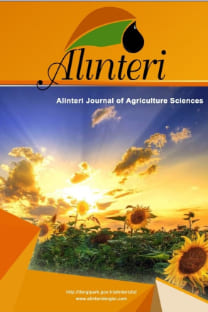Sinop'ta (Türkiye) Satışa Sunulan Dicentrarchus labrax (Linnaeus, 1758) ve Sparus aurata (Linnaeus 1758)’da Bazı Ağır Metal Konsantrasyonlarının İnsan Sağlığı Açısından Değerlendirilmesi
Sinop balık pazarında ticari olarak satışa sunulan Avrupa deniz levreği- Dicentrarchus labrax (Linnaeus, 1758) ve çipuranın- Sparus aurata Linnaeus, 1758, cıva (Hg), kadmiyum (Cd), kurşun (Pb), bakır (Cu) ve çinko (Zn) seviyeleri değerlendirilmiştir. Seçilen ağır metaller, örnek alınan balıkların yenilebilir dokularında İndüktif Olarak Birleştirilmiş Plazma Kütle Spektrometresi (ICP-MS) kullanılarak analiz edilmiştir. Sonuçlar, mg (kg yaş ağırlık)-1 cinsinden ifade edilmiştir. Her iki balık türünde de Zn daha yüksek konsantrasyonlarda tespit edilmiş ve bunu Cu izlemiştir. D. labrax türünde metal konsantrasyonları ortalama Hg için 0,03±0,008 mg (kg yaş ağırlık)-1 ; Cd için 0,009±0,001 mg (kg yaş ağırlık) -1 ; Pb için 0,06±0,02 mg (kg yaş ağırlık)-1 ; Cu için 0,42±0,09 mg (kg yaş ağırlık)-1 ve Zn için 9,2±3,1 mg (kg yaş ağırlık)-1 olarak bulunmuştur. S. aurata türünde ise, metal konsantrasyonları ortalama Hg için 0,02±0,006 mg (kg yaş ağırlık)-1 ; Cd için 0,01±0,009 mg (kg yaş ağırlık)-1 ; Pb için 0,04±0,011 mg (kg yaş ağırlık)-1 ; Cu için 0,69±0,11 mg (kg yaş ağırlık)-1 Zn için 8,5±2,3 mg (kg yaş ağırlık)-1 olarak bulunmuştur. Avrupa deniz levreği ve çipura için ağır metallerin hiçbiri izin verilen değerlerin üzerinde bulunmamıştır.
Assessment in Terms of Human Health Some Heavy Metals Concentrations Determined in Dicentrarchus labrax (Linnaeus, 1758) and Sparus aurata (Linnaeus, 1758) Marketed in Sinop (Turkey)
Mercury (Hg), cadmium (Cd), lead (Pb), copper (Cu) and zinc (Zn) levels in European sea bass Dicentrarchus labrax (Linnaeus, 1758) and gilthead sea bream Sparus aurata Linnaeus, 1758 that are commercially sold on the Sinop fish markets were appraised. Selected heavy metals were assayed in edible tissues of the sampled fish, using an Inductively Coupled Plasma Mass Spectrometry (ICP-MS). The results are expressed in mg (kg wet wt.) -1 . In both fish species, Cu was detected in higher concentrations, followed by Cu. The means of metal concentrations in D. labrax were 0.03±0.008 mg (kg wet wt.) -1 for Hg; 0.009±0.001 mg (kg wet wt.) -1 for Cd; 0.06±0.02 mg (kg wet wt.) -1 for Pb; 0.42±0.09 mg (kg wet wt.) -1 for Cu and 9.2±3.1 mg (kg wet wt.) -1 for Zn. Whereas the means of metal concentrations in S. aurata were 0.02±0.006 mg (kg wet wt.) -1 for Hg; 0.01±0.009 mg (kg wet wt.) -1 for Cd; 0.04±0.011 mg (kg wet wt.) -1 for Pb; 0.69±0.11 mg (kg wet wt.) -1 for Cu and 8.5±2.3 mg (kg wet wt.) -1 for Zn. None of the metals in European sea bass and gilthead sea bream were not above the permissible values.
___
- Alasalvar C., Taylor K.D.A., Zubcov E., Shahidi F. and Alexis M. 2002. Differentiation of cultured and wild sea bass (Dicentrarchus labrax): Total lipid content, fatty acid and trace mineral composition. Food Chemistry, 79: 145- 150.
- Bat L. 2014. Heavy metal pollution in the Black Sea. In: Düzgüneş E, Öztürk B, Zengin M. (Eds.). Turkish Fisheries in the Black Sea. Published by Turkish Marine Research Foundation (TUDAV), Publication number: 40, ISBN: 987-975- 8825-32-5 Istanbul, Turkey, p. 71-107.
- Bat L., Sezgin M., Şahin F., Birinci Özdemir Z. and Ürkmez D. 2013. Sinop city fishery of the Black Sea. Marine Science, 3(3): 55-64.
- Dural M., Lugal-Goksu M.Z., Ozak A.A. and Derici B. 2006. Bioaccumulation of some heavy metals in different tissues of Dicentrarchus labrax L., 1758, Sparus aurata L., 1758 and Mugil cephalus L., 1758 from the Çamlık Lagoon of the Eastern Cost of Mediterranean (Turkey). Environmental Monitoring and Assessment, 118: 65-74.
- EFSA Scientific Committee. 2015. Statement on the benefits of fish/seafood consumption compared to the risks of methylmercury in fish/seafood. EFSA Journal, 13(1): 3982-36.
- FAO/WHO. Summary report of the seventy-third meeting of JECFA, Joint FAO/WHO Expert Committee on Food Additives, Geneva, 2010.
- FAO/WHO. Joint FAO/WHO food standards programme codex committee on contaminants in foods, Fifth Session, working document for information and use in discussions related to contaminants and toxins in the GSCTFF, The Hague, The Netherlands, 90 p., 2011.
- TUIK, Turkish Fishery Statistics. 2016. http://www.tuik.gov.tr/.
- Türkmen M., Türkmen A., Tepe Y., Töre Y. and Ateş A. 2009. Determination of metals in fish species from Aegean and Mediterranean seas. Food Chemistry, 113: 233- 237.
- Uluozlu O.D., Tuzen M., Mendil D. and Soylak M. 2007. Trace metal content in nine species of fish from the Black and Aegean Seas, Turkey. Food Chemistry, 104: 835-840.
- Yabanli M., Alparslan Y. and Baygar T. 2012. Assessment of cadmium, mercury and lead contents of frozen Eurorean sea bass (Dicentrarchus labrax L., 1758) and gilthead sea bream (Sparus aurata L., 1758) fillets from Turkey. Agricultural Sciences, 3: 669-673.
- Yılmaz A.B. 2005. Comparison of heavy metal levels of grey mullet (Mugil cephalus L.) and sea bream (Sparus aurata L.) caught in İskenderun Bay (Turkey). Turkish Journal of Veterinary and Animal Sciences, 29: 257-262.
- ISSN: 2564-7814
- Başlangıç: 2007
- Yayıncı: Adem Yavuz SÖNMEZ
Sayıdaki Diğer Makaleler
Atilla TEMUR, MEHMET ALİ TEMİZ
LEVENT BAT, AYŞAH ÖZTEKİN, ELİF ARICI
Organik Yem Bitkileri Yetiştiriciliğinin Sorunları ve Çözüm Önerileri
Problems Face to Organic Forage Plant Improvement and Their Recommended Solutions
PCR-RFLP Metodu Kullanılarak Manda Leptin Geni Polimorfizminin Anadolu Mandalarında Karakterizasyonu
Endüstri Bitkileri ve Bitki Artıklarının Biyoyakıt Olarak Kullanımı
Extraction of Chitin from Crayfish (Astacus leptodactylus) Shell Waste
